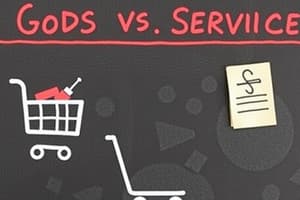Podcast
Questions and Answers
What is a key difference between goods and services regarding ownership?
What is a key difference between goods and services regarding ownership?
- Goods are intangible, while services can be owned.
- Both goods and services can be owned once purchased.
- Goods can be owned and transferred, while services can also be owned.
- Goods can be owned and transferred, while services cannot be owned. (correct)
How does the production and consumption of goods differ from that of services?
How does the production and consumption of goods differ from that of services?
- Goods require expert handling during consumption, while services do not.
- Goods are consumed simultaneously with production, whereas services can be stored.
- Goods can be produced, stored, and consumed later, while services are consumed as they are produced. (correct)
- Both goods and services are produced and consumed simultaneously.
Which aspect of quality assessment is more favorable for goods compared to services?
Which aspect of quality assessment is more favorable for goods compared to services?
- Both goods and services have consistent quality that can be pre-assessed.
- Goods are easier to evaluate based on reviews, whereas services are based on features.
- Goods have subjective quality assessment, while services have objective assessment.
- Quality of goods can be inspected before purchase, while services cannot be evaluated until after consumption. (correct)
What marketing strategy is typically more emphasized when promoting services?
What marketing strategy is typically more emphasized when promoting services?
Which of the following statements accurately describes the variability of goods versus services?
Which of the following statements accurately describes the variability of goods versus services?
Flashcards are hidden until you start studying
Study Notes
Definition
- Good: A tangible item that can be seen, touched, and owned.
- Service: An intangible activity or benefit provided to a customer.
Key Differences
-
Tangibility:
- Goods are physical objects (e.g., furniture, clothing).
- Services are actions or performances (e.g., haircuts, legal advice).
-
Ownership:
- Goods can be owned and transferred.
- Services cannot be owned; they are experienced.
-
Production and Consumption:
- Goods can be produced, stored, and consumed later.
- Services are often produced and consumed simultaneously.
-
Quality Assessment:
- Goods can be inspected before purchase; quality is measurable.
- Services are harder to evaluate before purchase; quality is subjective.
-
Variability:
- Goods have consistent quality and features.
- Services can vary based on provider, location, and time.
-
Duration:
- Goods have a longer lifespan (can exist for years).
- Services are typically short-term (immediate or temporary).
Examples
- Goods: Electronics, food items, clothing, cars.
- Services: Education, healthcare, entertainment, maintenance.
Economic Role
- Goods are often traded in markets for currency.
- Services contribute to economic activities and employment but do not result in ownership of a product.
Marketing Strategies
- Goods marketing focuses on features, packaging, and branding.
- Services marketing emphasizes customer experience, reliability, and customer service.
Definition
- Goods refer to tangible items that are visible, touchable, and can be owned.
- Services are intangible activities or benefits offered to customers.
Key Differences
-
Tangibility:
- Goods are physical items like furniture and clothing.
- Services represent actions or performances, such as haircuts or legal advice.
-
Ownership:
- Goods can be owned, transferred, or sold.
- Services are experiential and cannot be owned.
-
Production and Consumption:
- Goods can be manufactured, stored, and consumed at a later time.
- Services typically occur at the moment of production and consumption.
-
Quality Assessment:
- Goods allow for pre-purchase inspection and measurable quality.
- Services are challenging to evaluate beforehand, and quality is often subjective.
-
Variability:
- Goods maintain consistent quality and features across similar items.
- Services may differ in quality based on the provider, location, and timing.
-
Duration:
- Goods generally have a longer lifespan and can last for years.
- Services tend to be short-term, providing immediate or temporary benefits.
Examples
- Goods: Include electronics, food, clothing, and automobiles.
- Services: Include education, healthcare, entertainment, and maintenance services.
Economic Role
- Goods are traded in markets and exchanged for currency.
- Services play a critical role in economic activities and employment, but do not result in ownership of a physical product.
Marketing Strategies
- Marketing for goods emphasizes features, packaging, and branding.
- Marketing for services focuses on enhancing customer experience, reliability, and overall customer service.
Studying That Suits You
Use AI to generate personalized quizzes and flashcards to suit your learning preferences.




